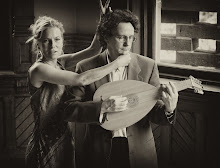
Here's the program and the notes.
Maria Cortegiano
Ricercar Franciscus Bossinensis (fl 1509)
Se non dormi donna ascolta Anon.
Ricercar Bossinensis
O passi sparsi Sebastiano Festa (d. 1524)
Ricercar Bossinensis
Piango el mio fidel servire Anon.
Ricercar Bossinensis
O dolce diva mia Peregrinus Cesena (fl 1510-20)
Tullia d'Aragona c. 1510-56
Varchi il cui raro
Fantasias (Nos. 5,6 &7) Francesco da Milano (1497-1543)
S'io'l feci unqua
Franceschina Bellamano
Donna se 'l cor Ippolito Tromboncino (fl 1540-60s)
Vostra belta si bella Tromboncino
Io moro Tromboncino
Se voi dolc'et pietosi Tromboncino
Intermission
Gaspara Stampa 1523-1554
Amor, lo stato tuo e proprio quale After Vincenzo Galilei (c. 1520-91)
El Pass'e Mezo – Gagliarda La Gasparina Giulio Abondante (fl1546 -1587)
Veronica Franco 1546-1591
Fors’anco Amor Cosimo Bottegari (1564-1620)
Lucia di Filippo Gagnolanti d. 1593
Romanesca Galilei
Torna deh torna Giulio Caccini (c1550–1618)
Fantasia Anon.
Fillide mia Caccini
Fantasia Anon.
Amarilli Caccini
Dalla porta d’oriente Caccini
If an aristocrat in Renaissance Italy were very liberal minded, he might let his wife embroider a pillow to place on the window sill to cushion her elbow while she watched the goings-on in the street. Wives were seldom anywhere unchaperoned and their lives were largely cloisetered.
The courtesan, on the other hand, was free to roam both amorously and intellectually. The ‘cortegiano honeste’ was musician, poet and muse. She didn’t have a price list and customers, she had ‘friends’ who gave her ‘gifts’. Pietro Aretino, a satirist who knew a thing or two about courtesans, tells us that musical instruments and musical hangers-on were among the most important things for the aspiring courtesan to acquire. In one of Aretino’s dialogues Nanna, an old pro, tells Pippa, her protégé, ‘Ask this man for a lute, another for a harpsichord, this man for a viola and that for a lira. Then get the maestri to come and teach you music, getting them to play for you for nothing, paying them with hopes and promises.’
What we know about Maria the courtesan’s repertoire comes from a manuscript of poetry collected by a Domenico Arrighi. He seems to have been quite smitten by Maria, a Roman who moved to Florence. Many of the poems have notes saying that she sang this one or that and these rubrics are often more effusive: ‘This song was her favorite, and she sang it so well that everyone would fall in love with her on hearing her sing it so beautifully.’ We have intabluated the tenor and bass parts of Se non dormi, Piango and O dolce diva for lute since this was the most common mode of performance for the frottola. O passi sparsi is from an English arrangement of Festa’s frottola which is the most famous setting of Petrarch’s text.
Hardly any music survives for the lira da braccio, an instrument which was used to accompany quasi-improvised solo recitation-song in the 15th and 16th century. Hallie reconstructs such a performance from such sources as do survive to perform poems by the most celebrated of the courtesan poets, Tullia. As well as her sonnets, which include many to lovers and patrons like Varchi, she published a philosophic Dialogue on the Infinity of Love from which this concert takes its name. Who better to write on the subject than a professional?
Pietro Aretino was an avid letter writer, and published collections of them. One letter invites the greatest singing teacher of Renaissance Venice, Ippolito Tromboncino, to dinner, saying that the courtesan, and Ippolito’s student, Francheschina will be there, as will the great painter Titian. A painting of Titian’s shows a disinterested Venus staring off into the distance as a lute player serenades her longingly. Could this be Ippolito and Franceschina? He certainly looks as if he will be rewarded with nothing but ‘hopes and promises’.
The performance of poetic forms to stock melodic and chord changes was perhaps the most common form of song in our period. We perform Gaspara’s sonnet to a formula which fits all sonnets and uses the Folia chord changes. The lute chords are notated in rudimentary notation in the hand of Vincenzo Galilei, though we obtain the melody other sources. We sing a passage from one of Veronica’s long terza rime to a textless ‘aria’ for that poetic form from Cosimo Bottegari’s lute song book. We have also sung passages from Dante’s Inferno to the same tune, since any terza rima can be performed to it.
But it’s not clear who was a courtesan. Gaspara was of noble birth, but her family was broke. She had several lovers who gave her ‘gifts’. Lucia was a singer at the Medici court. When there was some doubt about the potency of a noble who was about to marry a Medici daughter Lucia was sent to Venice (what happens in Venice stays in Venice) with the man in question. When she became pregnant the test was passed and he wed the Medici. Lucia was married to singer and composer Giulio Caccini, who received a dowry of several times his annual salary, paid by Ferdinand de Medici. Sleeping with the boss’ future son-in-law in exchange for a huge cash payment for your household would seem to be far beyond the normal duties of a singer. The edges of courtesanship were quite blurry in the 16th century. We might be more certain saying courtesans were independent women, accomplished poets and musicians than women who took money for sex.

